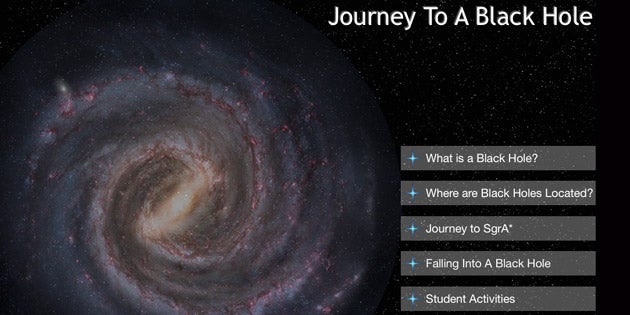College of Charleston Associate Professor of Physics and Astronomy Chris Fragile worked with two undergraduate students to create an educational app about black holes for the iPad, called “Journey to a Black Hole.” The app was made available for free in the Apple App Store as of July 28, 2014.
Winslow DiBona, computer science major and rising junior, along with Steven Draugel, physics-and-computer-science double major and rising senior, worked alongside Fragile to complete every aspect of the app.
RELATED: Check out Chris Fragile’s website to learn more about his expertise

Screenshot of the app’s main page
“The app is supposed to educate people on what black holes are, some of the scientific concepts behind them and elaborate on those concepts through activities and animations that can be used in the classroom,” DiBona said.
Outer space meets cyberspace
The first challenge the team faced was learning enough about app development to actually begin coding “Journey to a Black Hole.”
“They both did independent studies in the spring semester and taught themselves how to program an iPad app so that by the start of the summer they would be ready to start developing it,” Fragile said. “I gave them some ideas for content and the rest was up to them.”
The final content is laid out in a storyboard visible to all app users. It acts as a content guide so users can see what they will learn. Before it was embedded in the app, however, the storyboard was a list of items and concepts DiBona and Draugel hoped to include.
“In the beginning of the summer we sat down and wrote down the things we needed to have in the app,” DiBona explained. “Then we added lower-priority items that we hoped to include.”
“Over time we learned enough to get everything we wanted in the app, even better than we originally thought we could,” Draugel added.
Classroom application
The app is separated into lesson plans rated easy, medium or hard. Each difficulty rating corresponds to a recommended age group; kindergarteners through fifth graders use easy, sixth through eighth graders use medium and ninth grade students and up use hard.
Educating primary and secondary students on black holes falls in line with a larger effort on behalf of the College to spark an interest in science-technology-engineering-mathematics, or STEM fields, among grade-school-age children. Additionally, Fragile received a National Science Foundation grant of $189,653 that encouraged incorporating an outreach component to his work.
“One of the things the National Science Foundation always expects from a grant recipient is that they do something to allow the research to have a broader impact, so it’s not just for the scientific community,” Fragile said. “The grant is for research on simulations of accretion onto black holes, or gas falling into black holes. Specifically I study the interaction of radiation and gas. The project is related to the app in that the app discusses accretion and radiation as part of its bigger picture.”
RELATED: Learn more about “Journey to a Black Hole
A portion of the grant funding went to pay a stipend for 10 weeks of DiBona’s and Draugel’s work.
Though the app can be used interactively in classrooms, individuals who are interested in black holes can also use it independently as the lesson plan is easy to follow without an accompanying curriculum.
Preparing for Launch
After DiBona and Draugel completed their independent studies and spent several weeks over the summer working on the app, all that was left was fine-tuning it for approval through the App Store.
The two worked together to make sure each section of the app functions with the others, that the voice was consistent and that all the information was accurate and informative.
“Once we submitted the app, Apple went through to ensure that there were no bugs, that all the content is credited correctly, they went through the code and made sure nothing would mess with a user’s iPad,” DiBona said. “From there it was pretty straightforward, the app appeared in the App Store and it’s free to download.”
The app covers many concepts in addition to accretion, like spaghettification (Draugel explained, “the gravity of the black hole is so strong that if someone were to get sucked into a black hole feet first, their feet would be pulled significantly harder than the rest of their body and they’d be stretched out.”), the ergosphere (“a region around a rotating black hole where it is impossible to remain stationary”) and the singularity (“the infinitely dense point that lies at the center of black holes”).
The team is excited to help teach such complex concepts to new audiences through “Journey to a Black Hole.” To download the app, find it in the App Store or in iTunes.





